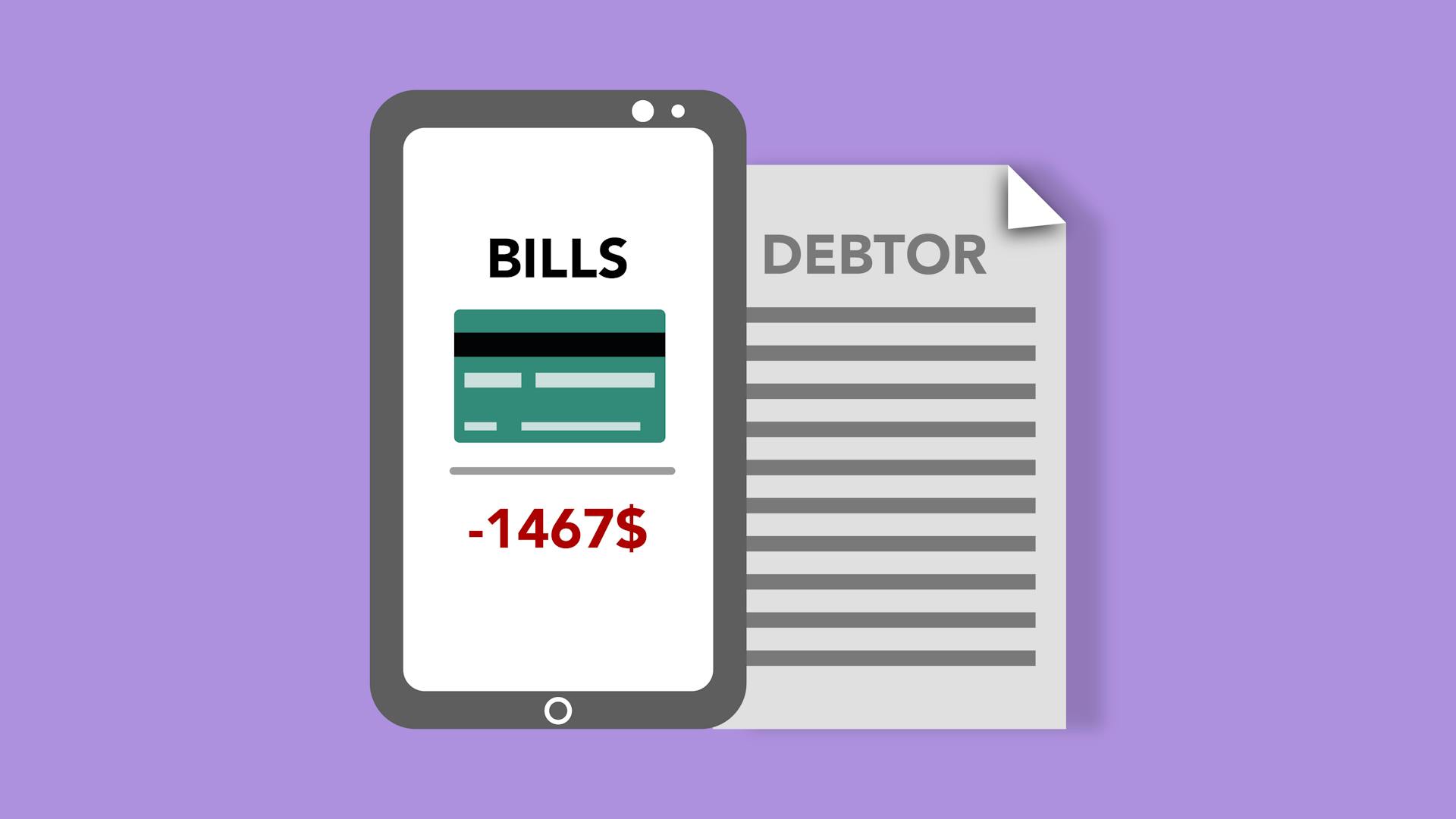
A good debt to asset ratio is crucial for financial stability, and it's essential to understand what it means. A debt-to-asset ratio of 0.5 or less is generally considered a safe range, as seen in the example of a company with a debt of $50,000 and assets of $100,000.
This ratio indicates that the company's debt is manageable and won't lead to financial instability. In contrast, a high debt-to-asset ratio can signal financial distress.
A debt-to-asset ratio of 0.5 or less means that for every dollar of debt, a company has two dollars of assets to cover it. This is a key indicator of a company's ability to pay off its debts.
Having a low debt-to-asset ratio can provide peace of mind and reduce stress, allowing individuals to focus on long-term financial goals.
See what others are reading: Statutory Liquidity Ratio Means
Calculating the Debt to Asset Ratio
Calculating the debt to asset ratio is a straightforward process that requires a few simple steps. To start, you need to gather your data, which includes a company's total debt and total assets.
Total debt includes all types of debt, such as loans, credit cards, and mortgages, which are categorized as liabilities on the company's balance sheet. You can usually find a company's recent financial statements on their website.
Total assets, on the other hand, include anything a company owns and uses to make revenue, such as money in checking and savings accounts, inventory, equipment, property, accounts receivable, and short and long-term investments.
Once you have both numbers, you can calculate the debt to asset ratio by dividing the total debt by the total assets. This will give you a ratio, such as 0.60, which can be converted to a percentage by multiplying the value by 100.
For example, if a company has a total debt of $33,450 and total assets of $28,600, the debt to asset ratio would be 1.17, indicating that the company is funding a large part of its assets strictly by debt. On the other hand, a company with a debt to asset ratio of 0.35, like Company B in the example, has more flexibility to invest in more assets and increase its overall revenue.
Recommended read: The Current Ratio Measures a Company's
Here's a simple formula to calculate the debt to asset ratio:
Debt to Asset Ratio = Total Debt / Total Assets
You can also compare the ratio in multiple periods to check for stability. A good debt to asset ratio is generally considered to be less than 0.5, although this can vary depending on the industry and company.
Keep in mind that a higher debt to asset ratio means a higher degree of leverage, which can result in a higher risk of defaulting on loans and debts.
Interpreting the Debt to Asset Ratio
A debt to asset ratio of less than 0.5 is often considered a good sign, as it indicates a company has manageable leverage.
However, it's essential to consider the industry norms, as different sectors have varying benchmarks for what constitutes a healthy debt to asset ratio. For instance, pipeline companies tend to have higher debt to asset ratios than technology companies due to their stable cash flows.
To accurately interpret the debt to asset ratio, it's crucial to evaluate the ratio at different times to track its change. This helps account for the limitations of the ratio, such as the exclusion of intangible assets from the total assets.
Importance
Understanding the importance of debt to asset ratio analysis is crucial for evaluating a company's financial health. A debt ratio of 29.3% like Amazon's suggests a manageable financial risk.
A moderate debt ratio can indicate a balanced approach to leverage, but different industries have varying benchmarks for what constitutes a healthy debt ratio. This means that a company's debt ratio should be evaluated in the context of its industry.
A significant portion of a company's assets not dependent solely on debt financing is a positive sign. This can provide a safety net in case of financial difficulties.
Curious to learn more? Check out: Is Freedom Debt Relief a Good Company
Interpretation
Interpreting the debt to asset ratio requires considering the company's industry and specific circumstances. A high debt to asset ratio can indicate a company is highly leveraged, making it more susceptible to financial difficulties.
A fresh viewpoint: A Company Having No Debt Good
Companies with a debt to asset ratio above 0.5 may struggle to repay their debts, especially during economic downturns. For example, a highly leveraged company may face financial difficulties if interest rates rise suddenly.
A low debt to asset ratio, typically below 0.5, suggests a company has a stable financial foundation. However, this doesn't necessarily mean the company is not using debt at all.
Industry benchmarks play a crucial role in interpreting the debt to asset ratio. For instance, pipeline companies often have a higher debt to asset ratio than technology companies due to their more stable cash flows.
Here's a rough guide to help you understand the debt to asset ratio:
Keep in mind that the debt to asset ratio has its limitations, such as not including intangible assets in the total assets. To increase accuracy, you can evaluate the ratio at different times to follow its change.
Industry and Business Considerations
Debt ratios can vary significantly across different industries. A utility company's debt ratio is likely to be higher than a software company's.
For instance, a utility company might have a debt ratio of 70% or higher, which is much higher than the average debt ratio for software companies. This is because utility companies often require large upfront investments in infrastructure, which can lead to higher debt levels.
However, a high debt ratio in one industry doesn't necessarily mean a company is less risky overall. It's essential to consider the company's specific circumstances and goals.
Real World Examples
In the real world, companies use debt ratios to assess their financial health and make informed decisions. A debt ratio of 1.0x, like Company A's, indicates a company's debt is equal to its assets, which is a neutral position.
Company B's debt ratio of 0.5x suggests it has a lower risk profile, with less debt compared to its assets. This can be beneficial for investors and creditors, as it implies a lower likelihood of default.
You might enjoy: How to Get Debt to Income Ratio down
A debt ratio of 2.0x, like Company C's, is a warning sign, indicating a company's debt is double its assets. This can lead to financial difficulties and increased risk for investors and creditors.
Here's a breakdown of the components that make up a company's debt ratio:
- Total Assets: This includes all a company's assets, such as cash, inventory, and property.
- Short-term Debt: This includes debts that need to be repaid within a year, such as loans and accounts payable.
- Current Portion of Long-term Debt: This includes the portion of long-term debt that needs to be repaid within a year.
- Long-term Debt: This includes debts that need to be repaid over a year or more, such as bonds and mortgages.
For example, a company with $527,854 million in total assets and $8,419 million in short-term debt would have a relatively low debt ratio.
Industry
Comparing debt ratios among different companies is only meaningful if they're similar in terms of industry and revenue model.
A utility company's debt ratio is likely to be higher than a software company's, but that doesn't necessarily make the software company less risky.
Companies in the same industry tend to have similar debt ratios due to shared characteristics and challenges.
For example, a software company's debt ratio might be lower than a utility company's, but that doesn't mean the software company is more financially stable overall.
Industry-specific factors can greatly impact a company's debt ratio, making it essential to consider these differences when evaluating financial health.
Business Loans
Business loans can be a crucial part of a company's financial strategy, helping to support cash flow needs and unexpected expenses.
To qualify for a business loan, lenders evaluate a company's debt-to-asset ratio, which is the amount of debt compared to the company's total assets. A high debt-to-asset ratio can make it harder to get a loan.
The lender will also check the company's liquidity, which is the ability to pay debts when they are due. This helps ensure the company can meet its payment obligations.
A company's debt-to-income ratio is also important, as it shows how much of its income goes towards debt payments. A healthy debt-to-income ratio makes the application process smoother and faster.
Businesses can use loans to finance equipment and machinery, such as office equipment or manufacturing machinery. The lender will check the company's debt-to-asset ratio to see if it can afford regular debt payments.
By understanding the basics of business loans, companies can make informed decisions about their financial future.
Personal Finance and Homeownership
Buying a home is a significant milestone, and banks consider your debt-to-income ratio to determine if you can afford future mortgage payments. A debt-to-income ratio of 41.6% might be acceptable, but it depends on the bank's policies.
To qualify for a mortgage, your estimated monthly mortgage payments should be manageable alongside your other debts. For example, if your estimated monthly mortgage payments are $2,328 and you have $1,000 in other outstanding debts, your total debt is $3,328. This is a significant amount, especially if you have a pre-tax monthly income of $8,000.
Building a strong credit history is crucial for future financial goals, and lenders review your debt balances and income during the loan or credit card application process. A healthy debt-to-income ratio makes the application process smoother and faster.
Homeownership
Buying a home is a significant milestone, and banks carefully consider your debt-to-income ratio before approving a mortgage. A debt-to-income ratio of 41.6% is considered relatively high, as in the example of a $350,000 mortgage with an estimated monthly payment of $2,328.
Your pre-tax monthly income plays a crucial role in determining your mortgage eligibility, with $8,000 being the monthly income in the given example. Banks want to ensure you can afford future payments, which is why they examine your debt-to-income ratio.
Loans and Credit
To get a loan or credit card, lenders check your debt-to-income ratio, which is the amount of debt you have compared to your income. This helps them determine if you can afford regular payments.
A healthy debt-to-income ratio makes the application process smooth and fast. This is because you'll have a better chance of meeting payment obligations.
Businesses also use loans and credit cards to support cash flow needs or pay unexpected expenses. Before approving a loan, lenders evaluate the company's debt-to-asset ratio and liquidity.
A company with too much debt relative to expenses might find it harder to get a loan. This is because the lender will be concerned about the business's ability to meet payment obligations.
The debt-to-income ratio is a key factor in loan and credit card applications. It helps lenders understand how much debt you can handle and whether you'll be able to make payments on time.
If this caught your attention, see: Why Credit Card Debts Are Called Unsecured Debt
Sources
- https://www.wallstreetprep.com/knowledge/debt-ratio/
- https://www.highradius.com/resources/Blog/what-is-debt-ratio-with-formula-and-calculation/
- https://greenlight.com/learning-center/credit/debt-to-asset-ratio
- https://www.carboncollective.co/sustainable-investing/debt-to-asset-ratio
- https://ebizcharge.com/tools/debt-asset-ratio-calculator/
Featured Images: pexels.com


